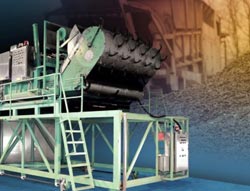Energy from microbes for drying sewage sludge

<br>
When dried with the new process, sludge from wastewater treatment can be used as fertilizer, dumped in landfills or incinerated. Unlike thermal drying processes, the new technique, known as “mechanically enhanced biodrying” or MEB, does not require any outside source of heat.
Instead, it uses the energy produced by microbes in the sludge. The operational costs are therefore 30 percent lower compared to thermal drying processes.
The first use of the technique in a large wastewater treatment plant will occur in the Chinese city of Shenyang. Beginning in the fall of 2012, the plant will dry 1,000 metric tons of wet sludge per day. It will be the largest sewage sludge treatment plant in the world that uses a non-thermal technique.
Wastewater treatment gives rise to large quantities of runny sludge that contains a low proportion of solid matter. The water usually has to be drained from this sludge before it can be used, dumped in landfills or incinerated, and this is often accomplished via pressing. A solids content of approximately 20 percent can be achieved this way. In some countries this semisolid sludge is spread on fields as fertilizer or dumped in landfills.
In some countries, however, a solids content of at least 60 percent is mandated for these purposes, and this was recently prescribed by law in China as well. In order to attain this high percentage of solid matter, the sludge must be dried. This can be accomplished very rapidly with thermal processes, which demand a great deal of energy. Alternatively, the sludge can be dried with help from the sun, but this can take up to two months.
The Siemens solution increases the solids content of the sewage sludge from 20 to 65 percent within about 22 days; after that, the resulting product can be used as fertilizer or fuel, or it can be disposed of in landfills. The heat required for the drying is produced by biological processes. Microbes break down nutrients in the sludge and generate heat in the process.
The only other type of energy needed is mechanical energy to aerate and mix the sludge in order to keep the biological processes going. A six-month pilot test at a composting plant in the town of Merrimack in the U.S. state of New Hampshire has shown that this technique works even at ambient temperatures as low as minus ten degrees Celsius.
The sewage sludge is automatically aerated and mixed in a controlled process. The system is enclosed, so that any odors can be trapped with a biofilter. The new process is particularly well suited to developing countries where energy is scarce but an abundance of land is available.
Media Contact
More Information:
http://www.siemens.com/innovationnewsAll latest news from the category: Ecology, The Environment and Conservation
This complex theme deals primarily with interactions between organisms and the environmental factors that impact them, but to a greater extent between individual inanimate environmental factors.
innovations-report offers informative reports and articles on topics such as climate protection, landscape conservation, ecological systems, wildlife and nature parks and ecosystem efficiency and balance.
Newest articles

Properties of new materials for microchips
… can now be measured well. Reseachers of Delft University of Technology demonstrated measuring performance properties of ultrathin silicon membranes. Making ever smaller and more powerful chips requires new ultrathin…

Floating solar’s potential
… to support sustainable development by addressing climate, water, and energy goals holistically. A new study published this week in Nature Energy raises the potential for floating solar photovoltaics (FPV)…

Skyrmions move at record speeds
… a step towards the computing of the future. An international research team led by scientists from the CNRS1 has discovered that the magnetic nanobubbles2 known as skyrmions can be…





















